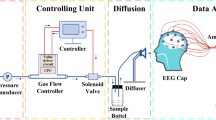Abstract
Electroencephalography (EEG) is a widely used technique that allows researchers to measure neural activity that demonstrates how the human brain reacts to various environmental stimuli or imaginations. In this study, EEG was used to determine the brain’s reactions during the imagination of the most pleasant and unpleasant odors among four kinds of odors, including orange, clove, thyme, and mint. The distinguishability of brain responses to these odors was tested using the Hilbert transform, Fast Walsh–Hadamard transform, band power, and spectrogram image features. The results showed that the Hilbert Transform-based features have great potential to classify the EEG signals recorded during the imagination of the most pleasant and unpleasant odors. The proposed method achieved an average classification accuracy of 87.75% for the test data with a k-nearest neighbor classifier.





Similar content being viewed by others
Explore related subjects
Discover the latest articles, news and stories from top researchers in related subjects.Data availability
Data have been previously presented and can be provided after the request from the corresponding author.
References
Dzau V, Balatbat C (2018) Health and societal implications of medical and technological advances. Science Trans Mede 10(463):eaau4778. https://doi.org/10.1016/j.mayocp.2020.07.040
Weber Y, Biskup S, Helbig K, Von Spiczak S, Lerche H (2017) The role of genetic testing in epilepsy diagnosis and management. Expert Rev Mol Diagn 17(8):739–750. https://doi.org/10.1080/14737159.2017.1335598
Moreira F, Sale M, Di Lorenzo M (2017) Towards timely Alzheimer diagnosis: a self-powered amperometric biosensor for the neurotransmitter acetylcholine. Biosens Bioelectron 87:607–614. https://doi.org/10.1016/j.bios.2016.08.104
Dauwels J, Vialatte FB, Cichocki A (2011) On the early diagnosis of Alzheimer’s disease from EEG signals: a mini-review. Adv Cogn Neurodyn II:709–716. https://doi.org/10.1007/978-90-481-9695-1_106
De Oliveira A, De Santana M, Andrade M, Gomes J, Rodrigues M, dos Santos W (2020) Early diagnosis of Parkinson’s disease using EEG, machine learning and partial directed coherence. Res Biomed Eng 36(3):311–331. https://doi.org/10.1007/s42600-020-00072-w
Sharma M, Acharya U (2021) Automated detection of schizophrenia using optimal wavelet-based l1 norm features extracted from single-channel EEG. Cogn Neurodyn 15(4):661–674. https://doi.org/10.1007/s11571-020-09655-w
Chan W, Levsen M, McCrae C (2018) A meta-analysis of associations between obesity and insomnia diagnosis and symptoms. Sleep Med Rev 40:170–182. https://doi.org/10.1016/j.smrv.2017.12.004
Corsi MC, Chavez M, Schwartz D, Hugueville L, Khambhati A, Bassett D, De Vico Fallani F (2019) Integrating EEG and MEG signals to improve motor imagery classification in brain-computer interface. Int J Neural Syst 29(01). https://doi.org/10.1142/S0129065718500144
Zhang Y, Guo D, Li F, Yin E et al (2018) Correlated component analysis for enhancing the performance of SSVEP-based brain-computer interface. IEEE Trans Neural Syst Rehabil Eng 26(5):948–956. https://doi.org/10.1109/tnsre.2018.2826541
Aydemir O (2017) Olfactory recognition based on EEG gamma-band activity. Neural Comput 29(6):1667–1680. https://doi.org/10.1162/NECO_a_00966
Kroupi E, Yazdani A, Vesin JM, Ebrahimi T (2014) EEG correlates of pleasant and unpleasant odor perception. ACM Tran Multimedia Comput Commun Appl (TOMM) 11(1):1–17. https://doi.org/10.1145/2637287
Yazdani A, Kroupi E, Vesin JM, Ebrahimi T (2012) Electroencephalogram alterations during perception of pleasant and unpleasant odors. IEEE, Melbourne. https://doi.org/10.1109/qomex.2012.6263860
Pistoia F, Carolei A, Iacoviello D et al (2015) EEG-detected olfactory imagery to reveal covert consciousness in minimally conscious state. Brain Inj 29(13–14):1729–1735. https://doi.org/10.3109/02699052.2015.1075251
Djordjevic J, Zatorre R, Petrides M, Boyle J, Jones Gotman M (2005) Functional neuroimaging of odor imagery. Neuroimage 24(3):791–801. https://doi.org/10.1016/j.neuroimage.2004.09.035
Aydemir O, Naser A, Ozturk M, (2020) Classification of EEG signals recorded while imagining odors with effective band pass filter parameters. In: 2020 28th signal processing and communications applications conference (SIU) Gaziantep. https://doi.org/10.1109/siu49456.2020.9302244
Sirinukunwattana K, Raza S, Tsang YW, Snead D, Cree I, Rajpoot N (2016) Locality sensitive deep learning for detection and classification of nuclei in routine colon cancer histology images. IEEE Trans Med Imag 35(5):1196–1206. https://doi.org/10.1109/tmi.2016.2525803
Wu H, Prasad S (2017) Semi-supervised deep learning using pseudo labels for hyperspectral image classification. IEEE Trans Image Process 27(3):1259–1270. https://doi.org/10.1109/tip.2017.2772836
Freeman W (2007) Hilbert transform for brain waves. Scholarpedia 2(1):1338. https://doi.org/10.4249/scholarpedia.1338
Freeman W, Burke B, Holmes M (2003) Aperiodic phase re-setting in scalp EEG of beta-gamma oscillations by state transitions at alpha-theta rates. Hum Brain Mapp 19(4):248–272. https://doi.org/10.1002/hbm.10120
Saka K, Aydemir O, Ozturk M (2016) Classification of EEG signals recorded during right/left hand movement imagery using Fast Walsh Hadamard Transform based features.In: 2016 39th international conference on telecommunications and signal processing (TSP). Vienna. https://doi.org/10.1109/tsp.2016.7760909
Saraiva A, Castro F, Nascimento R, Melo R et al (2020) Electroencephalography applied compression algorithms qualitative analysis. Comput Methods Biomech Biomed Eng Imaging Visual 8(4):367–373. https://doi.org/10.1080/21681163.2019.1673212
Aydemir O (2020) Detection of highly motivated time segments in brain computer interface signals. IETE J Res 66(1):3–13. https://doi.org/10.1080/03772063.2018.1476190
Junwei L, Ramkumar S, Emayavaramban G, Vinod D et al (2018) Brain computer interface for neurodegenerative person using electroencephalogram. IEEE Access 7:2439–2452. https://doi.org/10.1109/access.2018.2886708
Yuan L, Cao J (2017) Patients’ EEG data analysis via spectrogram image with a convolution neural network. In: International conference on intelligent decision technologies. https://doi.org/10.1007/978-3-319-59421-7_2
Ramos Aguilar R, Olvera Lopez J, OlmosPineda I, Sanchez Urrieta S (2020) Feature extraction from EEG spectrograms for epileptic seizure detection. Pattern Recogn Lett 133:202–209. https://doi.org/10.1016/j.patrec.2020.03.006
Acknowledgements
This study was supported by The Scientific and Technological Research Council of Turkey (TUBITAK) with project number 118E241. In addition, the authors thank the participants who participated in the experiment.
Author information
Authors and Affiliations
Corresponding author
Ethics declarations
Conflict of interest
The authors declare that there is no conflict of interest.
Additional information
Publisher's Note
Springer Nature remains neutral with regard to jurisdictional claims in published maps and institutional affiliations.
Rights and permissions
Springer Nature or its licensor (e.g. a society or other partner) holds exclusive rights to this article under a publishing agreement with the author(s) or other rightsholder(s); author self-archiving of the accepted manuscript version of this article is solely governed by the terms of such publishing agreement and applicable law.
About this article
Cite this article
Naser, A., Aydemir, O. Classification of pleasant and unpleasant odor imagery EEG signals. Neural Comput & Applic 35, 9105–9114 (2023). https://doi.org/10.1007/s00521-022-08171-8
Received:
Accepted:
Published:
Issue Date:
DOI: https://doi.org/10.1007/s00521-022-08171-8




